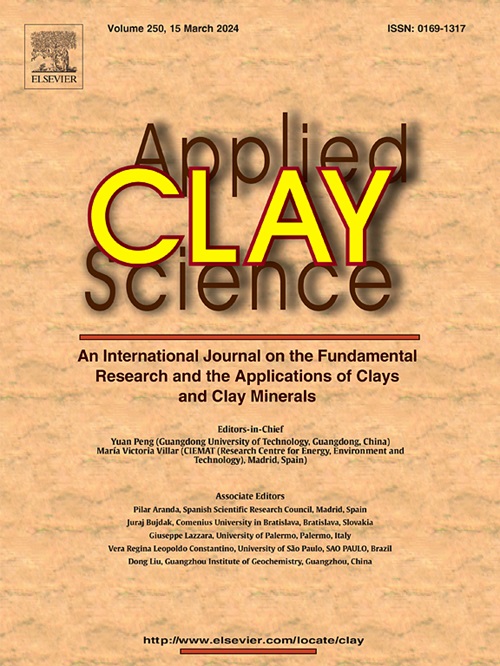Surfactants aided bleaching of raw kaolin and production of delaminated nano clays via sequential milling
IF 5.3
2区 地球科学
Q2 CHEMISTRY, PHYSICAL
引用次数: 0
Abstract
Industrial surfactants possessing specific functional groups are better known for obtaining stable clay dispersions. However, the effect of surfactants on the bleaching of kaolin clays during mechanical milling has not yet been studied. In this work, surfactants-assisted bleaching of kaolin clays was investigated through sequential milling (up to 3 stages) to develop an acid-free, water-based green-bleaching process. The aim of this work was to screen the surfactants that offer insitu bleaching thereby improving the brightness without any reductive bleaching using sodium dithionate, and directly produce size-controlled nano-clay particles. Kaolin clays of Indian origin were subjected to mechano-chemical bleaching via planetary milling in the presence of cationic, anionic, and polymeric surfactants in aqueous medium at neutral pH and 300 rpm for 10 min duration. The bleaching efficiency was monitored carefully by noting the color index properties. The end-products were also analyzed for the powder XRD, XRF, Near IR, color coordinates and morphology. The results confirmed that the three-stage mechanical-milling is effective in bleaching of kaolin clays when surfactants like Sodium Dodecyl Sulfate (SDS), commercially known as Sodium Lauryl Sulfate (SLS), is employed. The L* value of kaolin clay is enhanced from 83 to 90 and the b* value decreased from 12.47 to 1.98 in these surfactants. The SEM and TEM analyzes revealed that the mechano-chemical milling was also favoring the delamination of the kaolin clay booklets to produce nano-kaolin. Hence the technique is two-in-one to successfully produce optically bright, highly dispersible, IR reflective, kaolin nano-platelets through green-strategy.
表面活性剂辅助漂白原料高岭土和生产分层纳米粘土通过顺序碾磨
具有特定官能团的工业表面活性剂以获得稳定的粘土分散体而闻名。然而,机械磨粉过程中,表面活性剂对高岭土漂白的影响尚未得到研究。在这项工作中,通过连续磨矿(多达3个阶段)研究表面活性剂辅助高岭土的漂白,以开发一种无酸,水基绿色漂白工艺。本工作的目的是筛选提供原位漂白的表面活性剂,从而在不使用二硫酸钠进行还原性漂白的情况下提高亮度,并直接生产尺寸可控的纳米粘土颗粒。印度原产的高岭土在中性pH和300转/分的水介质中,在阳离子、阴离子和聚合物表面活性剂的存在下,通过行星研磨进行机械化学漂白,持续10分钟。通过观察染料的显色指数,对漂白效果进行了严密的监测。对最终产物进行了粉末XRD、XRF、近红外光谱、色坐标和形貌分析。结果证实,当使用十二烷基硫酸钠(SDS),商业上称为十二烷基硫酸钠(SLS)等表面活性剂时,三级机械磨粉对高岭土粘土的漂白是有效的。这些表面活性剂使高岭土的L*值由83提高到90,b*值由12.47降低到1.98。SEM和TEM分析表明,机械-化学磨矿也有利于高岭土颗粒的分层制备纳米高岭土。因此,这项技术是二合一的,可以通过绿色策略成功地生产出光学明亮、高度分散、红外反射的高岭土纳米血小板。
本文章由计算机程序翻译,如有差异,请以英文原文为准。
求助全文
约1分钟内获得全文
求助全文
来源期刊

Applied Clay Science
地学-矿物学
CiteScore
10.30
自引率
10.70%
发文量
289
审稿时长
39 days
期刊介绍:
Applied Clay Science aims to be an international journal attracting high quality scientific papers on clays and clay minerals, including research papers, reviews, and technical notes. The journal covers typical subjects of Fundamental and Applied Clay Science such as:
• Synthesis and purification
• Structural, crystallographic and mineralogical properties of clays and clay minerals
• Thermal properties of clays and clay minerals
• Physico-chemical properties including i) surface and interface properties; ii) thermodynamic properties; iii) mechanical properties
• Interaction with water, with polar and apolar molecules
• Colloidal properties and rheology
• Adsorption, Intercalation, Ionic exchange
• Genesis and deposits of clay minerals
• Geology and geochemistry of clays
• Modification of clays and clay minerals properties by thermal and physical treatments
• Modification by chemical treatments with organic and inorganic molecules(organoclays, pillared clays)
• Modification by biological microorganisms. etc...
 求助内容:
求助内容: 应助结果提醒方式:
应助结果提醒方式:


